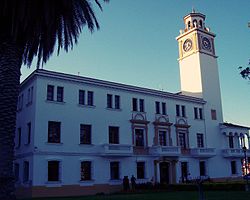Santiago del Estero Province
province of Argentina From Wikipedia, the free encyclopedia
province of Argentina From Wikipedia, the free encyclopedia
Santiago del Estero is a province in the north of Argentina. Its capital is the city of Santiago del Estero
Santiago del Estero | |
|---|---|
 Government building in Santiago del Estero | |
 Location of Santiago del Estero within Argentina | |
| Coordinates: 27°47′0″S 64°16′0″W | |
| Country | Argentina |
| Capital | Santiago del Estero |
| Departments | 27 |
| Municipalities | 28 |
| Government | |
| • Governor | Gerardo Zamora |
| Area | |
| • Total | 136,351 km2 (52,645 sq mi) |
| Population (2010) | |
| • Total | 874,006 |
| • Density | 6.4/km2 (17/sq mi) |
| Demonym | Santiagueño |
| Time zone | UTC−3 (ART) |
| ISO 3166 code | AR-G |
| Website | www |
The province of Santiago del Estero has an area of 136,351 km2 (52,645 sq mi); the province is in the northern part of the country and is surrounded by the provinces Salta, Chaco, Santa Fe, Córdoba, Catamarca and Tucumán.
Most of the province is in the Gran Chaco flat lands with some low places where some small lakes are formed. In some low places, there are wetlands that are known here as Esteros.
The main rivers of the province are the Dulce, that is known as Salí river in Tucumán, and the Salado.
Santiago del Estero has an arid climate, subtype Bsh in the Köppen climate classification.
The average temperature for the year in Santiago del Estero is 20.4 °C (68.7 °F). The warmest month, on average, is January with an average temperature of 26.9 °C (80.4 °F). The coolest month on average is June, with an average temperature of 12.3 °C (54.1 °F).
The average amount of precipitation for the year in Santiago del Estero is 546.1 mm (21.5 in). The month with the most precipitation on average is January with 104.1 mm (4.1 in) of precipitation. The month with the least precipitation on average is July with an average of 5.1 mm (0.2 in).[1]
The inhabitants of Santiago del Estero are known, in Spanish, as Santiagueños (women: Santiagueñas).
The province of Santiago del Estero has a population, in 2010, of 874,006;[2] its population density is of 6.4 inhabitants/km2.
Evolution of the population in Santiago del Estero

The province is divided into 27 departments (Spanish: departamentos).
| No. | Department | Capital | Area[3] (km²) |
Population[2] (2010) |
Density |
|---|---|---|---|---|---|
| 1 | Aguirre | Pinto | 3,692 | 7,610 | 2.1 |
| 2 | Alberdi Department | Campo Gallo | 13,507 | 17,252 | 1.3 |
| 3 | Atamisqui | Villa Atamisqui | 10,923 | 2,259 | 4.8 |
| 4 | Avellaneda | Herrera | 3,902 | 20,763 | 5.3 |
| 5 | Banda | La Banda | 3,597 | 142,279 | 39.6 |
| 6 | Belgrano | Bandera | 3,314 | 9,243 | 2.8 |
| 7 | Capital | Santiago del Estero | 2,116 | 267,125 | 126.2 |
| 8 | Choya | Frías | 6,492 | 34,667 | 5.3 |
| 9 | Copo | Monte Quemado | 12,604 | 31,404 | 2.5 |
| 10 | Figueroa | La Cañada | 6,695 | 17,820 | 2.7 |
| 11 | General Taboada | Añatuya | 6,040 | 38,105 | 6.3 |
| 12 | Guasayán | San Pedro de Guasayán | 2,588 | 7,602 | 2.9 |
| 13 | Jiménez | Pozo Hondo | 4,832 | 14,352 | 3.0 |
| 14 | Juan Felipe Ibarra | Suncho Corral | 9,139 | 16,937 | 1.9 |
| 15 | Loreto | Loreto | 3,337 | 20,036 | 6.0 |
| 16 | Mitre | Villa Unión | 3,667 | 1,890 | 0.5 |
| 17 | Moreno | Quimilí | 16,127 | 32,130 | 2.0 |
| 18 | Ojo de Agua | Villa Ojo de Agua | 6,269 | 14,008 | 2.2 |
| 19 | Pellegrini | Nueva Esperanza | 7,330 | 20,514 | 2.8 |
| 20 | Quebrachos | Sumampa | 3,507 | 10,568 | 3.0 |
| 21 | Río Hondo | Termas de Río Hondo | 2,124 | 54,867 | 25.8 |
| 22 | Rivadavia | Selva | 3,402 | 5,015 | 1.5 |
| 23 | Robles | Fernández | 1,424 | 44,415 | 31.2 |
| 24 | Salavina | Los Telares | 3,562 | 11,217 | 3.1 |
| 25 | San Martín | Brea Pozo | 2,097 | 9,831 | 4.7 |
| 26 | Sarmiento | Garza | 1,549 | 4,607 | 3.0 |
| 27 | Silípica | Arraga | 1,179 | 7,712 | 6.5 |
Seamless Wikipedia browsing. On steroids.
Every time you click a link to Wikipedia, Wiktionary or Wikiquote in your browser's search results, it will show the modern Wikiwand interface.
Wikiwand extension is a five stars, simple, with minimum permission required to keep your browsing private, safe and transparent.